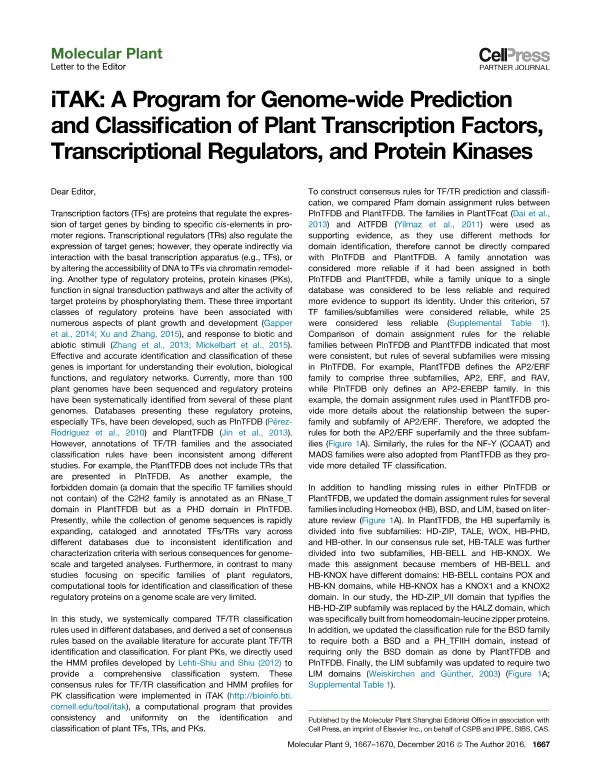Mostrar el registro sencillo del ítem
dc.contributor.author
Zheng, Yi
dc.contributor.author
Jiao, Chen
dc.contributor.author
Sun, Honghe
dc.contributor.author
Rosli, Hernan Guillermo

dc.contributor.author
Pombo, Marina Alejandra

dc.contributor.author
Zhang, Peifen
dc.contributor.author
Banf, Michael
dc.contributor.author
Dai, Xinbin
dc.contributor.author
Martin, Gregory B.
dc.contributor.author
Giovannoni, James J.
dc.contributor.author
Zhao, Patrick X.
dc.contributor.author
Rhee, Seung Y.
dc.contributor.author
Fei, Zhangjun
dc.date.available
2019-09-25T17:55:47Z
dc.date.issued
2016-12
dc.identifier.citation
Zheng, Yi; Jiao, Chen; Sun, Honghe; Rosli, Hernan Guillermo; Pombo, Marina Alejandra; et al.; iTAK: A Program for Genome-wide Prediction and Classification of Plant Transcription Factors, Transcriptional Regulators, and Protein Kinases; Elsevier; Molecular Plant; 9; 12; 12-2016; 1667-1670
dc.identifier.issn
1674-2052
dc.identifier.uri
http://hdl.handle.net/11336/84418
dc.description.abstract
Transcription factors (TFs) are proteins that regulate the expression of target genes by binding to specific cis-elements in promoter regions. Transcriptional regulators (TRs) also regulate the expression of target genes; however, they operate indirectly via interaction with the basal transcription apparatus (e.g. TFs), or by altering the accessibility of DNA to TFs via chromatin remodeling. Another type of regulatory proteins, protein kinases (PKs), function in signal transduction pathways and alter the activity of target proteins by phosphorylating them. These three important classes of regulatory proteins have been associated with numerous aspects of plant growth and development (Gapper et al., 2014; Xu and Zhang, 2015), and response to biotic and abiotic stimuli (Mickelbart et al., 2015; Zhang et al., 2013). Effective and accurate identification and classification of these genes is important for understanding their evolution, biological functions, and regulatory networks. Currently, more than 100 plant genomes have been sequenced and regulatory proteins have been systematically identified from several of these plant genomes. Databases presenting these regulatory proteins, especially TFs, have been developed, such as PlnTFDB (Pérez-Rodríguez et al., 2010) and PlantTFDB (Jin et al., 2013). However, annotations of TF/TR families and the associated classification rules have been inconsistent among different studies. For example, the PlantTFDB does not include TRs that are presented in PlnTFDB. As another example, the ?forbidden? domain (a domain that the specific TF families should not contain) of the C2H2 family is annotated as an RNase_T domain in PlantTFDB, but as a PHD domain in PlnTFDB. Presently, while the collection of genome sequences is rapidly expanding, cataloged and annotated TFs/TRs vary across different databases due to inconsistent identification and characterization criteria with serious consequences for genome scale and targeted analyses. Furthermore, in contrast to many studies focusing on specific families of plant regulators, computational tools for identification and classification of these regulatory proteins on a genome scale are very limited.
dc.format
application/pdf
dc.language.iso
eng
dc.publisher
Elsevier

dc.rights
info:eu-repo/semantics/openAccess
dc.rights.uri
https://creativecommons.org/licenses/by-nc-sa/2.5/ar/
dc.subject
Itak
dc.subject
Database
dc.subject
Transcription Factors
dc.subject
Kinases
dc.subject.classification
Otras Biotecnología Agropecuaria

dc.subject.classification
Biotecnología Agropecuaria

dc.subject.classification
CIENCIAS AGRÍCOLAS

dc.title
iTAK: A Program for Genome-wide Prediction and Classification of Plant Transcription Factors, Transcriptional Regulators, and Protein Kinases
dc.type
info:eu-repo/semantics/article
dc.type
info:ar-repo/semantics/artículo
dc.type
info:eu-repo/semantics/publishedVersion
dc.date.updated
2019-09-23T13:33:49Z
dc.journal.volume
9
dc.journal.number
12
dc.journal.pagination
1667-1670
dc.journal.pais
Reino Unido

dc.journal.ciudad
Oxford
dc.description.fil
Fil: Zheng, Yi. Boyce Thompson Institute; Estados Unidos
dc.description.fil
Fil: Jiao, Chen. Boyce Thompson Institute; Estados Unidos
dc.description.fil
Fil: Sun, Honghe. Boyce Thompson Institute; Estados Unidos
dc.description.fil
Fil: Rosli, Hernan Guillermo. Consejo Nacional de Investigaciones Científicas y Técnicas. Centro Científico Tecnológico Conicet - La Plata. Instituto de Fisiología Vegetal. Universidad Nacional de La Plata. Facultad de Ciencias Naturales y Museo. Instituto de Fisiología Vegetal; Argentina. Boyce Thompson Institute; Estados Unidos
dc.description.fil
Fil: Pombo, Marina Alejandra. Consejo Nacional de Investigaciones Científicas y Técnicas. Centro Científico Tecnológico Conicet - La Plata. Instituto de Fisiología Vegetal. Universidad Nacional de La Plata. Facultad de Ciencias Naturales y Museo. Instituto de Fisiología Vegetal; Argentina. Boyce Thompson Institute; Estados Unidos
dc.description.fil
Fil: Zhang, Peifen. Carnegie Institution for Science; Estados Unidos
dc.description.fil
Fil: Banf, Michael. Carnegie Institution for Science; Estados Unidos
dc.description.fil
Fil: Dai, Xinbin. Samuel Roberts Noble Foundation; Estados Unidos
dc.description.fil
Fil: Martin, Gregory B.. Boyce Thompson Institute; Estados Unidos. Cornell University; Estados Unidos
dc.description.fil
Fil: Giovannoni, James J.. Boyce Thompson Institute; Estados Unidos. Center for Agriculture and Health; Estados Unidos
dc.description.fil
Fil: Zhao, Patrick X.. Samuel Roberts Noble Foundation; Estados Unidos
dc.description.fil
Fil: Rhee, Seung Y.. Carnegie Institution for Science; Estados Unidos
dc.description.fil
Fil: Fei, Zhangjun. Boyce Thompson Institute; Estados Unidos. Center for Agriculture and Health; Estados Unidos
dc.journal.title
Molecular Plant

dc.relation.alternativeid
info:eu-repo/semantics/altIdentifier/doi/http://dx.doi.org/10.1016/j.molp.2016.09.014
dc.relation.alternativeid
info:eu-repo/semantics/altIdentifier/url/https://www.sciencedirect.com/science/article/pii/S1674205216302234
Archivos asociados
